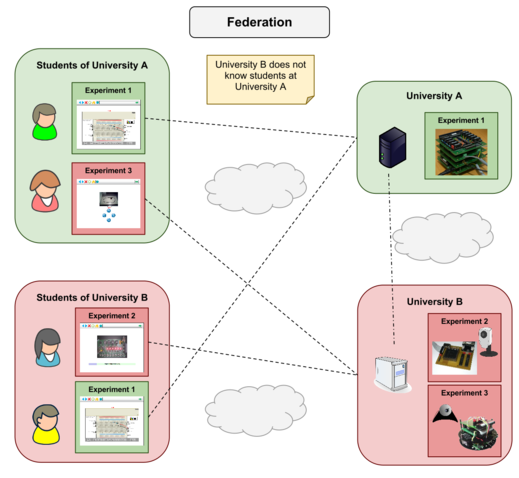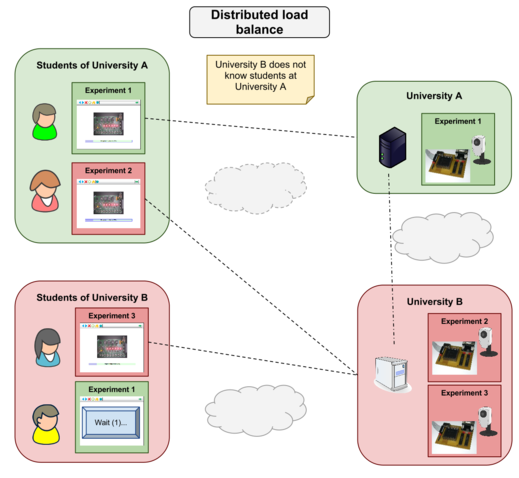Federation¶
WebLab-Deusto natively supports federating remote laboratories. This means that if two universities install WebLab-Deusto, any of the systems will be able to consume laboratories provided by the other university.

Table of Contents
See it in action¶
When you run the WebLab-Deusto demo, there is a particular laboratory called submarine. If you run it, you’ll see that whenever it is reserved, the web page redirects you to other domain (from www.weblab.deusto.es to fishtank.weblab.deusto.es). Internally, there are two independent WebLab-Deusto deployments there: one is the main system at Deusto, the other is a constrained system running in an ARM device (called IGEPv2). The first one (in this case, the consumer) is telling the second one (provider), “Hi, I’m ‘deusto’, and I want to use this laboratory that I’m granted for 250 seconds for a local user here called ‘demo’”. Later, the consumer will be requesting the provider for the user tracking, so the administrators of WebLab-Deusto will be able to track the ‘demo’ user.
Other way to test it is by deploying WebLab-Deusto (the basic default installation is a straightforward process). By default, the installation is a consumer of a federated system which is the main server of WebLab-Deusto. By adding different users and granting them permissions to the robots lab, and after accessing the lab with this user you’ll be able to see in the administrator panel that it has been used.
Finally, you can also see the federation video.
Features¶
Two main features are provided by WebLab-Deusto:
Transitivity¶
If you’re a provider of a laboratory, your consumers may technically re-share this laboratory. Basically, this enables subcontracting laboratories. See the transitive federation video.

Federated load balance¶
If there are multiple providers of a copy of a laboratory, you can balance the load of users among them automatically.

Examples¶
Other WebLab-Deusto deployments (in addition to the one in University of Deusto):
- LabsLand: https://weblab.labsland.com
- UNED: https://weblab.ieec.uned.es/
- HBRS: https://fpga-vision-lab.h-brs.de/weblab/
- Slovenská technická univerzita: http://weblab.chtf.stuba.sk/
- UPNA: https://weblab.unavarra.es/
- TU-Dortmund: https://weblab.zhb.tu-dortmund.de
- FH Aachen: https://weblab.fh-aachen.de
- UGA: https://remotelab.engr.uga.edu
- ISEP: https://openlabs.isep.ipp.pt/weblab/
- UNED (Costa Rica): https://labremoto.uned.ac.cr/weblab/
- UNAD: https://lab-remoto-etr.unad.edu.co/weblab/
- UNIFESP: https://weblab.unifesp.br/weblab/
- UFH: https://weblab.ufh.ac.za/weblab/
- University of Michigan: https://weblab.eecs.umich.edu/weblab/
- University of Washington: https://weblab.ece.uw.edu/weblab/
- Université Abdelhamid Ibn Badis Mostaganem: https://weblabdeusto.leog.univ-mosta.dz/weblab/
- PSUT: https://weblab.psut.edu.jo/weblab/
If you wish us to host a new deployment, contact us at weblab@deusto.es.